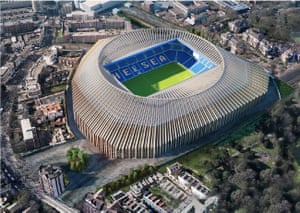ith its own dedicated fromagerie, microbrewery and Michelin-star restaurant, it might be easy to forget you have come to watch the football when you are reclining in one of the premium lounges of Tottenham Hotspur’s new £750m stadium. The 61,000-seat behemoth will feature the longest bar in the country, heated seats with built-in USB ports, a glass-walled tunnel so you can see the players before the game and even a “sky walk” allowing fans to clamber over the roof of the arena.
“It will be the most technically advanced stadium in the world,” says Christopher Lee, an architect with Populous, the sports and entertainment giant behind the design of the new-look White Hart Lane. “It has to provide a reason for people to get off their sofas and leave their 50-inch flatscreen TVs.”
As home entertainment systems become ever more elaborate, allowing fans to watch the action from every conceivable angle in ultra-high-definition, the conventional football stadium is having to up its game to lure people from the comfort of their homes. The promise of a pie, a pint and a good singsong in the stands just is not enough.
“People expect more from the experience and they’re willing to pay for it,” says Lee. While premium seat tickets to Tottenham’s gargantuan silver spaceship will start at £89, membership of its exclusive H Club – which comes with “provision for guests to store their personal vintage wines, cognacs and liquors in a purpose-built, temperature-controlled on-site reserve” – will cost £30,000 for two. That’s the price you must pay for enjoying a plate of specially sourced half-time cheese.
Besides the fancy catering, the football pitch itself has to work a lot harder, too. This is the first field of its kind designed to split into three parts and slide seamlessly under the seating stands, revealing an astroturf field beneath for American football, positioned at a lower level to ensure perfect sight lines for both modes of play. Acoustic consultants were brought on board in order to guarantee maximum amplification of crowd noise, ensuring a “wall of sound” will resonate from the 17,000-seat south stand, conceived as a single tier to rival the Kop at Anfield or the Yellow Wall at Borussia Dortmund’s Westfalenstadion.
So, having reached the apogee of transformable robotic pitches, exclusive fine dining suites and perfectly tuned seating, what next for the future of stadiums?
Lee, who has worked on major sports venues around the world, says technology is having a huge impact on how these buildings are being imagined. “Twenty years ago we put screens into stadiums,” he says. “But now we all carry a supercomputer in our pockets, so there are opportunities for layering the viewing experience – from seeing different camera angles in your seat, to tracking the heart rate, speed and impact of players wearing smart clothing on the pitch.”
He says the next big frontier is holographic representation, describing a world where players might be beamed on to the field from thousands of miles away. “In the not-too-distant future you can imagine Real Madrid supporters in São Paulo watching the game in their stadium at the same time as the fans in Spain,” he says. “It’s all about coming together for the collective experience.”

It may sound far-fetched but the technology is already here. In its bid for the 2022 World Cup, Japan promised to record games in 360 degrees with 200 HD cameras and broadcast them around the world live in 3D, allowing players to appear in hundreds of stadiums simultaneously as holographic projections. Microphones embedded below the pitch would have recorded every ball kick and tackle whimper, adding to the sense of realism.
While Japan’s sci-fi dream lost out to the rippling vaginal vision of Qatar’s stadium plans, it is American football in the US that is now leading the way in developing next generation venues. Given the eye-watering sums generated from the sale of TV rights (with deals worth $27bn), each team in the National Football League is desperately trying to build bigger video screens and provide faster in-seat wifi than the next, even if most fans will never have the chance to experience it in person. The new $1.6bn Atlanta Falcons stadium, currently under construction and due to open later this year, will feature the world’s first 360-degree video wall, running for 335m around the bowl, as well as a vast a rotating oculus roof, inspired by the wings of a falcon, made of eight 500-ton moving pieces. At one point it was even going to include vibrating seats.
“NFL has become an arms race,” says the architect John Rhodes of HOK, the firm behind the Atlanta project. “It used to be about sheer size, but now everyone’s focused on the convergence of the physical and digital experience, increasing connectivity in the stadium to bring fans closer to the players.”
He says that parametric modelling techniques are having an effect on the geometry of the seating bowl, too, the layout generated by a whole host of interconnected parameters, from acoustics to distance from the bar and proximity to the bench. He sees a future where the seating bowl might be fragmented into smaller groups of 50-100 people, creating “group suites” to intensify the physical and social interaction between fans, while drones will become a ubiquitous feature – for more than providing an elaborate backdrop to a Lady Gaga performance at half-time.
“I don’t imagine drones will be delivering beers to your seat, as some people think,” he says, “but I can definitely see linear bars served by drones running around the outside of concourse. It could have a revolutionary impact on how we think of concessions and eliminate queuing.”
Others are less enamoured with the high-tech dream. Jacques Herzog of Herzog & de Meuron, the Pritzker Prize-winning Swiss architects behind several renowned stadiums, from the inflatable bubble of the Allianz Arena in Munich to the steel tangle of Beijing Bird’s Nest, to the colossal brick cathedral of Chelsea’s forthcoming new stadium, thinks it might all be a distraction. “Everything is becoming too artificial,” he says. “It’s like when I watch my son playing Fifa on his console. If you have artificial lawns and roofs to keep out the rain and snow, you lose the physical authenticity of the moment and make it more of a virtual thing.”

He says his focus is always on capturing the local specificity of the place, designing a venue that somehow responds to the fan culture of the team in question, whether that’s a glowing lantern for Munich, a sharp white temple for Bordeaux, or an archaic masonry complex of vaults and buttresses for Stamford Bridge. For every project his practice reinvents the model.
“Our Bordeaux stadium is very refined to fit with the city’s elegant urban plan, but in London this would be absurd,” he says. “Equally if we took our Stamford Bridge project to Munich it would look like Lord of the Rings.” He describes his forthcoming Chelsea stadium as “almost Roman” in its raw heft, the polar opposite to Tottenham’s shiny UFO.
“Above all,” he adds, “both football and architecture need to keep that sense of the real. The smell of the grass, the proximity of the players to the fans. People come to watch games to have all of their senses stimulated – that’s what architecture must amplify.”







